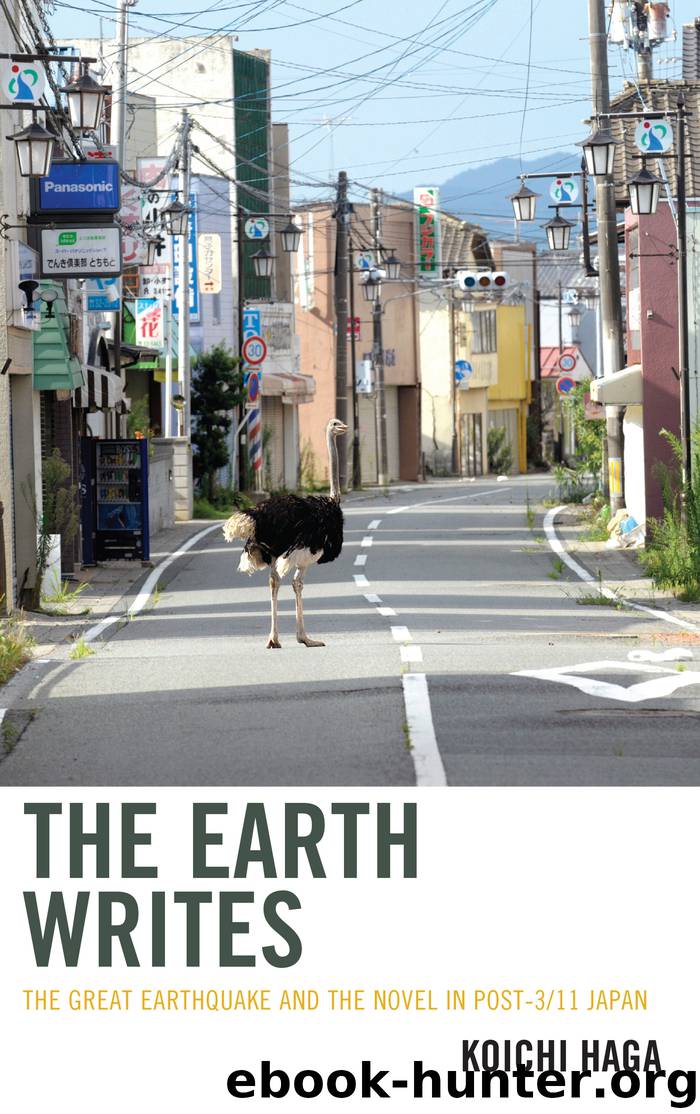The Earth Writes by Koichi Haga;

Author:Koichi Haga;
Language: eng
Format: epub
Tags: undefined
Publisher: Rowman & Littlefield Publishing
Published: 2012-06-02T16:00:00+00:00
Overlapping Ancient and
Contemporary Japan
In 2016, Svetlana Alexievich, a Nobel laureate, a Belarusian journalist and a non-fiction writer, visited Fukushima. She mentioned to the media that after talking with the local people, she found no organized culture of “resistance” among them.[2] Her comment is quite interesting when comparing post-3/11 Fukushima and post-Chernobyl Belarus under the Soviet regime. Hiroshi Kainuma, publisher of Fukushima-Why the Nuclear Village Was Born (2011), points out that even though the local residents of the areas adjacent to the nuclear plants in Fukushima and the government and industries had different visions and intentions, they shared a common desire to modernize the area through the use of nuclear energy.[3] Relationships between the Japanese government, TEPCO, Fukushima’s local governments, and the local people are an ambivalent mix of attraction and revulsion; in the end, however, all parties decided to entrust their dreams for the advancement of the region to the nuclear plant. Kainuma states further that although construction of the nuclear plants was a form of internal colonialism, to forcefully demand the suspension of the plants, thereby threatening the economic survival of the locals would be another form of violence.[4] In some cases, local people have denied the legitimacy of criticism of the government’s nuclear policy and TEPCO’s response to the accident.
Ironically, this situation is comparable to that of the Tōhoku region in the eighth to ninth centuries. The imperial court accelerated the centralization of the state after the Taika reforms of 645, building fortresses in the southern parts of the Tōhoku region (including Niigata, Yamagata, and Miyagi prefectures). Today’s Fukushima prefecture came under the control of state authority by the seventh century and formed the battlefront against Emishi society. In 724, the court built Taga castle near Sendai and its leaders functioned as the regional government overseeing today’s Tōhoku region. They further ordered the citizens of the state (mostly in the Kanto region) to settle around the fortresses and the castle, in order to push the Emishi further to the north. However, the state’s policy met resistance on several fronts, and the 38 Years War between the imperial state and the Ezo began in 774. In 780, Emishi rebels burned down Taga castle, forcing the state to send an unprecedented number of troops led by the Shogun to defeat the Emishi leader, Aterui.
Emishi society was composed of loosely connected groups that were never really united to fight; in fact, the state often exploited antagonism between Emishi groups to reduce their power. Aterui was a rare case in that many Emishi groups followed his orders and together they ultimately defeated the state army. However, the Emishi could not maintain their resistance against determined military actions by the state. Aterui was eventually captured and killed, forcing many other Emishi prisoners to resettle in various parts of Japan. After these massive military campaigns of the eighth to the early ninth centuries, the state shifted its policy to a more peaceful one, using local powers to govern the region. During this colonization process,
Download
This site does not store any files on its server. We only index and link to content provided by other sites. Please contact the content providers to delete copyright contents if any and email us, we'll remove relevant links or contents immediately.
| African | Asian |
| Australian & Oceanian | Canadian |
| Caribbean & Latin American | European |
| Jewish | Middle Eastern |
| Russian | United States |
4 3 2 1: A Novel by Paul Auster(11764)
The handmaid's tale by Margaret Atwood(7424)
Giovanni's Room by James Baldwin(6782)
Asking the Right Questions: A Guide to Critical Thinking by M. Neil Browne & Stuart M. Keeley(5339)
Big Magic: Creative Living Beyond Fear by Elizabeth Gilbert(5327)
Ego Is the Enemy by Ryan Holiday(4922)
On Writing A Memoir of the Craft by Stephen King(4650)
The Body: A Guide for Occupants by Bill Bryson(4560)
Ken Follett - World without end by Ken Follett(4428)
Bluets by Maggie Nelson(4245)
Adulting by Kelly Williams Brown(4214)
Eat That Frog! by Brian Tracy(4133)
Guilty Pleasures by Laurell K Hamilton(4102)
White Noise - A Novel by Don DeLillo(3819)
The Poetry of Pablo Neruda by Pablo Neruda(3802)
Fingerprints of the Gods by Graham Hancock(3722)
Alive: The Story of the Andes Survivors by Piers Paul Read(3715)
The Book of Joy by Dalai Lama(3675)
The Bookshop by Penelope Fitzgerald(3609)
